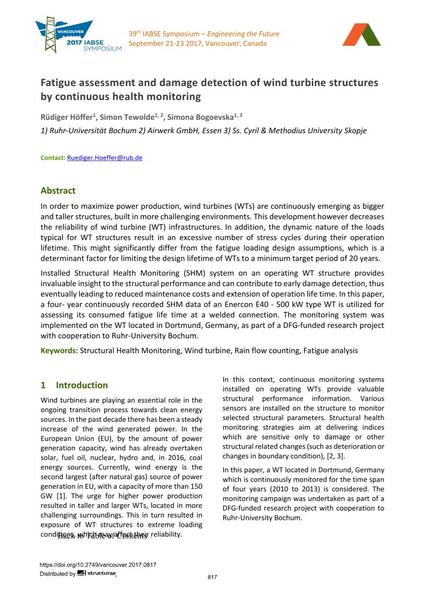Fatigue assessment and damage detection of wind turbine structures by continuous health monitoring

|
|
|||||||||||
Détails bibliographiques
| Auteur(s): |
Rüdiger Höffer
(Ruhr-Universität Bochum
)
Simon Tewolde (Ruhr-Universität Bochum; Airwerk GmbH, Essen ) Simona Bogoevska (Ruhr-Universität Bochum; Ss. Cyril & Methodius University Skopje) |
||||
|---|---|---|---|---|---|
| Médium: | papier de conférence | ||||
| Langue(s): | anglais | ||||
| Conférence: | IABSE Symposium: Engineering the Future, Vancouver, Canada, 21-23 September 2017 | ||||
| Publié dans: | IABSE Symposium Vancouver 2017 | ||||
|
|||||
| Page(s): | 817-824 | ||||
| Nombre total de pages (du PDF): | 8 | ||||
| Année: | 2017 | ||||
| DOI: | 10.2749/vancouver.2017.0817 | ||||
| Abstrait: |
In order to maximize power production, wind turbines (WTs) are continuously emerging as bigger and taller structures, built in more challenging environments. This development however decreases the reliability of wind turbine (WT) infrastructures. In addition, the dynamic nature of the loads typical for WT structures result in an excessive number of stress cycles during their operation lifetime. This might significantly differ from the fatigue loading design assumptions, which is a determinant factor for limiting the design lifetime of WTs to a minimum target period of 20 years. Installed Structural Health Monitoring (SHM) system on an operating WT structure provides invaluable insight to the structural performance and can contribute to early damage detection, thus eventually leading to reduced maintenance costs and extension of operation life time. In this paper, a four- year continuously recorded SHM data of an Enercon E40 - 500 kW type WT is utilized for assessing its consumed fatigue life time at a welded connection. The monitoring system was implemented on the WT located in Dortmund, Germany, as part of a DFG-funded research project with cooperation to Ruhr-University Bochum. |
||||
| Mots-clé: |
éolienne
|
||||
